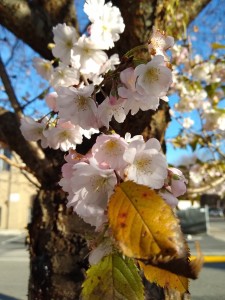 Old habits die hard. The Winter Solstice is in sight, but I still look for flowers when I take my daily walks. After all, hope, unlike the spring season, springs eternal.
Old habits die hard. The Winter Solstice is in sight, but I still look for flowers when I take my daily walks. After all, hope, unlike the spring season, springs eternal.
Even more surprising than my stubborn optimism is the fact that lately my hopes have been rewarded. Ornamental cherry trees are flowering at several locations in my neighborhood. At least one property is home to a row of blooming azaleas, and a neighbor has a white-flowered heath in bloom in her front garden.
Is it climate change, witchcraft or the overall strangeness of 2020? Some or all of those factors may be in play, but for the most part, the December blooms owe their existence to the unique DNA of some genera, hybrids and species.
The cherry trees are most likely varieties of the popular higan cherry or Prunus subhirtella, sometimes labeled Prunus x subhirtella for its probable origin as a natural hybrid of two other Japanese species. ‘Autumnalis’ features a heavy crop of semi-double pink flowers in spring, followed by a somewhat less bountiful showing in fall. Once the fall flowers fade—or even sometimes before they fade—the leaves turn yellow and depart the scene.
‘Autumnalis’ and its darker-flowered sibling, ‘Autumnalis Rosea’, can grow between 20 and 35-feet tall and up to 30-feet wide. Most of the specimens I have noticed lately have been smaller than those dimensions, probably because they are growing as street trees and subject to all kinds of stresses. Like most ornamental cherries, the trees are fast growers, but are relatively short-lived, thriving for thirty to forty years.
The December azaleas that I spotted flanked a front walkway and featured dark red blooms on relatively low-growing shrubs. They were almost certainly part of the Encore line of trademarked azalea varieties. At least 30 Encore azaleas are commercially available at the moment, in shades of white, pink, rose, lavender and purple. All of the Encore azaleas have the word “Autumn” in their trade names.
Encore azaleas came about because azalea lover Robert Edward Lee of Independence, Louisiana, wanted more. He grew lots of azaleas, cross-pollinated some species, and selected the most promising offspring. Eventually Lee made an agreement with Alabama-based Plant Development Services to continue the hybridization and plant selection process that culminated in the new line of fall-blooming azaleas. The first Encore azaleas became commercially available in 1997, and have been popular ever since.
Like the higan cherries, Encore azaleas bloom most heavily in the spring, but produce respectable shows of flowers in the fall as well. The caveat is that the spring show many not be as magnificent as that of once-blooming azaleas. Breeders are undoubtedly working on that, but for the moment, losing a small amount of spring abundance is the price you pay for fall inspiration.
Other breeders have gotten into the reblooming azalea act, and now consumers can by repeat bloomers that do not bear the Encore name. The color range has widened, as well.
If you are interested in buying either Encore or other reblooming varieties, check plant tags for information about cold hardiness. My USDA plant hardiness zone is “seven”, which means that I live and garden in a cold winter climate, with an average minimum temperature of zero degrees Fahrenheit to 10 degrees Fahrenheit. Some of the Encore azaleas do better than others in this zone, but most of them are not hardy farther north–USDA plant hardiness zones “six” and lower.
And what about that white-flowered heath? It is probably one of the varieties or hybrids of Erica carnea, also known as spring, winter or snow heath. Related to heathers, which fall into the Calluna genus, these plants are acid-loving, evergreen groundcovers with needle-like leaves. Growing only six to 10 inches tall, but spreading to about 20 inches wide, they mound nicely. The flowers are tiny, plentiful, and resemble elongated bells ranging along the stems. My neighbor’s plant might be a variety like Erica x darleyensis ‘Katia’, a hybrid that flowers from early through late winter. ‘Katia’s blooms are white, but flower colors also include shades of pink and red. Some varieties boast double flowers.
These late fall/early winter bloomers lift spirits at a time when the sun practices the “late to rise, early to set” schedule that drives so many of us into Seasonal Affective Disorder. They also provide food for any pollinators that might be overwintering or at least lurking around in search of a little sustenance.
Good for the psyche and good for the bees. It doesn’t get better than that as winter settles in.
